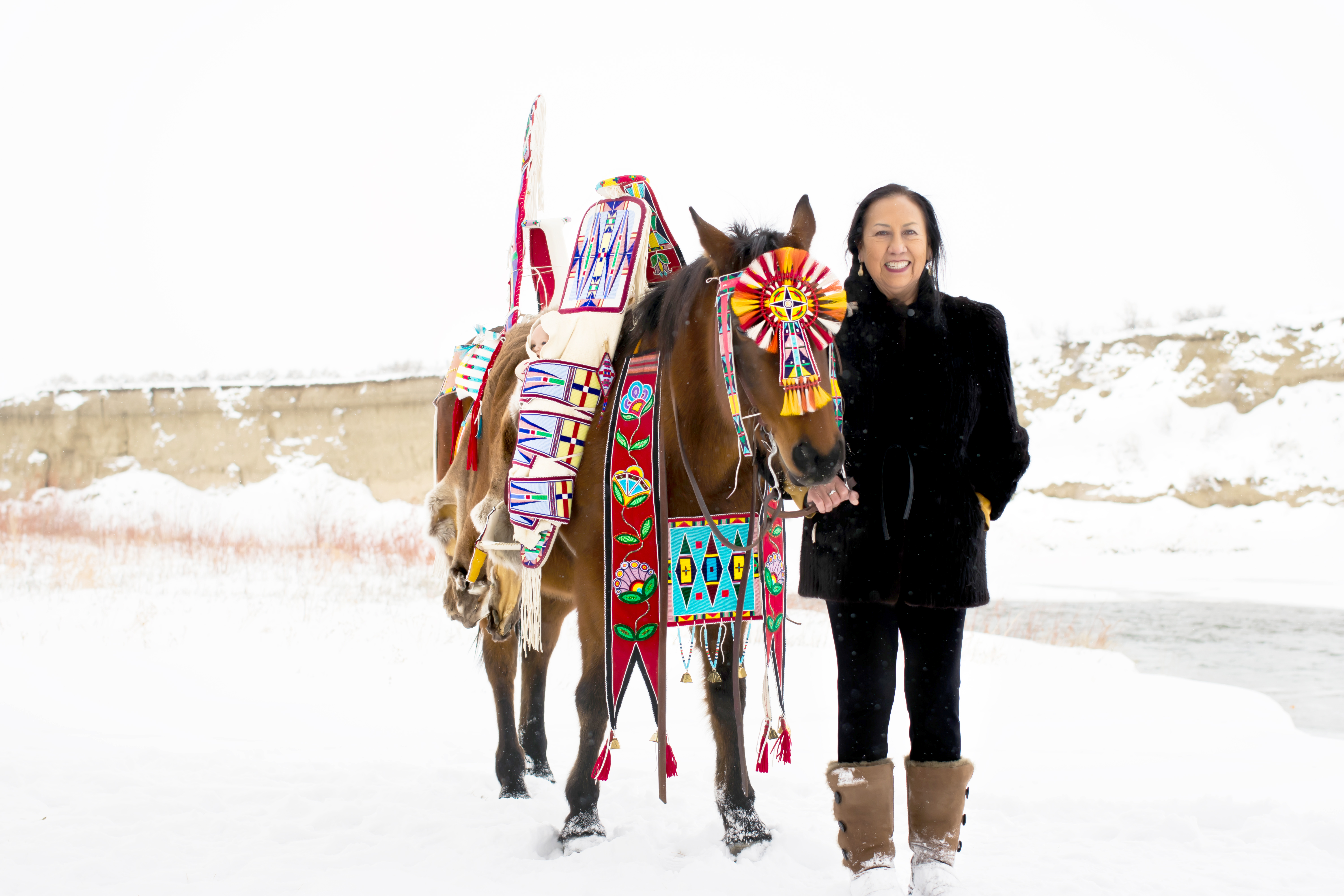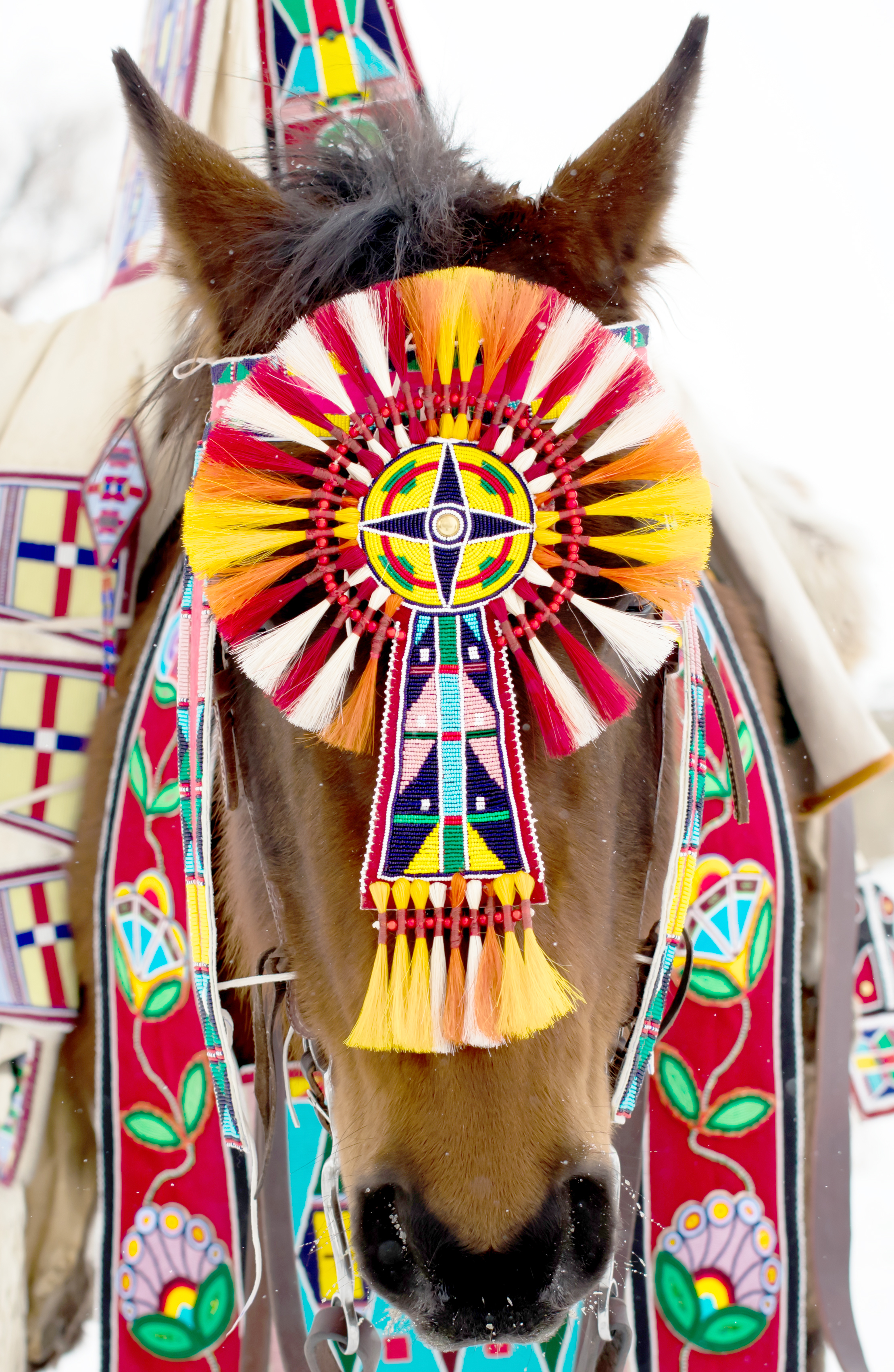
Birdie Real Bird
“Pandemic beading,” as Birdie Real Bird calls it, helped keep her sane during 2020 and the COVID-19 pandemic. “It keeps you thinking and going and being creative. Staying home, people got really depressed, but I didn’t.”
Real Bird, a beadwork artist and member of the Apsáalooke tribe who was raised on the Crow Reservation, isn’t one to stay still. During the pandemic, she started working on a set of parade regalia with intention to enter the finished pieces into the Heard Museum’s annual Indian Fair and Market in Phoenix.
The Heard Museum’s mission is to present stories of American Indian people from a first-person perspective. The 2021 competition, held in March, was the museum’s 63rd annual event and showcased more than 300 artists from 75 tribal affiliations. Real Bird’s entry, Horse Medicine, was awarded second place in the Division E category for culturally based work inspired by tradition, both functional and/or decorative, and she was also honored with the Indian Arts and Crafts Association Commemorative Award.
This was the first competition and art show Real Bird had entered, though she’s been beading since age 12. She had recently sold her personal horse regalia—11 pieces in total—and it was eating at her.
“I felt really bad that I didn’t have anything like that,” said Real Bird. “I decided when the pandemic started, I was going to concentrate on that.”

Real Bird was in a tough situation when she sold her hand-beaded items. Her log home in Garryowen was overtaken with bats. They were hanging from its top beams, making her residence uninhabitable. To mitigate the situation, Real Bird needed a substantial sum, and she knew her hand-beaded horse trappings would fetch it.
“To live in my house without fear and live there peacefully, I was desperate. So that’s what I did. That was the only thing that I could fall back on. Beading has been very good to me.”
This wasn’t the first time that particular set of trappings left Real Bird’s possession. It was crafted in the 1980s for the wife of her brother’s friend. The items came back to the family after she passed away, but Real Bird said her brother subsequently sold the collection. “I found all those pieces at a pawn shop, picked them all back up and started adding here and there.”
Other members of the family, including Real Bird’s granddaughters and grandson, and her niece’s daughter, have used the trappings. “Regalia is something that gets shared,” explained Real Bird. “This one that I have right now, I will parade in it before I let anyone else parade in it.”
The new trappings took her a year to complete, but were made in record time. “Well…If you stay home and you don’t go anywhere, you get a lot done,” said Real Bird.
During 2020, Real Bird also walked daily.
“When I’m beading, I do a lot of walking. I bead and I sit for hours, but I get up and I walk several miles a day.”
Real Bird resides in Garryowen, near Medicine Tail Cooley, and adjacent to the Little Bighorn battlefield. “Where I live is where the Cheyenne camped during the battle,” she described.
Real Bird is descended from beaders and warriors. Her father, Jim Real Bird, was the grandson of Annie Medicine Crow-Real Bird and Frank Bethune. Annie, known as a skilled beadworker and kind woman who helped raise many of her grandchildren, was the only daughter of Chief Medicine Crow.
Real Bird beads in a style that she learned from observing Apsáalooke artifacts in museum collections. She first began by replicating a martingale she saw in the Buffalo Bill Center of the West, copying the design of the piece that rests on the breastbone of the horse. She then adapted the floral design on the sides of the martingale, which hang from the horse’s neck, into a creation inspired by the late 1800s design.
The original design is characteristic of Crow style, with light blue beads surrounding geometric shapes appearing as an hourglass. The plate is framed with pink beads and has a bold, red-beaded background. Such colors were some of the first beads that Europeans began trading to the Crow in the 1800s.
“Beads saved me,”
described Real Bird, who started beading when she was a teenager.
“If it wasn’t for beads, I would be an alcoholic. In my younger days, it was hard for me. Pretty soon, I let my friends go, and I’d say, ‘I’m going to sit with my beads tonight,’ and that kept happening. Now, through the pandemic, I sat with my beads and created.”
Real Bird said her grandmother taught her how to bead, and instructed her to bead in small circles, around and around to create points. “She said, ‘If you get these points, you’re going to be a good beader,’ and just kept telling me that…I must have been a good beader, because she trusted me with making medallions.” The two would sell their creations, which were worn as necklaces.
It wasn’t until much later that Real Bird would be interested in replicating traditional Crow designs. “We were just creating our own designs,” she recalled.
Decades later, traditional designs called to her. “I just love the simple, delicate look of their work. They seem so easy, but they weren’t. And, they only had a few colors of beads…navy blue, light blues, turquoise…several colors that Crows used for background color; and then there was red. There was always red.”
As beading became ingrained into the Crow tribe’s fabric and beads became more and more plentiful, the Apsáalooke began to bead elaborately.
“Back in the day, everyone was a beader,” said Real Bird. “Decorating your horse, decorating your kids, decorating your husband and decorating yourself was all part of living. We had to look good, I guess.”

Carrying forward such a tradition, Real Bird admits she has even beaded in her sleep. She’s a scholar of traditional Crow beadwork and frequents museums to study the archives.
“Every time you look, you’ll find something new,” said Real Bird, who most recently spent time in the archives of Chicago’s Field Museum, where she was one of several members of the Crow tribe brought together to present Apsáalooke Women and Warriors. The exhibition opened in March 2020, during the beginnings of the COVID-19 pandemic in the U.S., but it was quickly closed with the rest of the country’s museums. Earlier this year, the Field Museum reopened the exhibit to the public.
Apsáalooke Women and Warriors, curated by Nina Sanders, a scholar and member of the Real Bird family, pairs historic and contemporary items from the Crow tribe’s history, held by the Field Museum. It was the first major exhibit curated by a Native American, in collaboration with her community, in the museum’s 126-year history.
Of the archives at the Field Museum, Real Bird said, “It’s a mysterious place, and I’ve been in a lot of archives.” She began a fascination with museum collections in the mid 1990s, when she visited the Peabody Museum in Boston and was able to view their collection of Crow Indian artifacts.
“Ever since then, I’ve been checking into archives and museums,” Real Bird said.
Real Bird is enthusiastic about having a full set of parade regalia again. “I love it. I feel good about it, because I have it, and I’m going to keep it unless someone wants to buy it for $50,000,” she said with a grin. At the Heard show, every piece was also for sale, and that was the price tag she assigned to her work.
“Those things, you don’t just come by them anytime. It’s a lot of work. That piece of mind in my house, that was more important at the time, but I’m glad I have my other pieces now.”
Images courtesy of Shelby Means Photography
Tags: Native News, Montana Art News, Birdie Real Bird, Montana Arts Council and beading